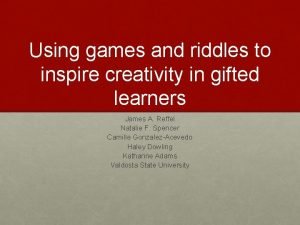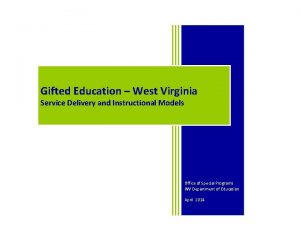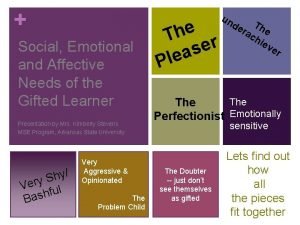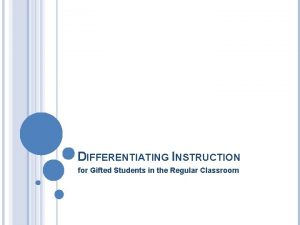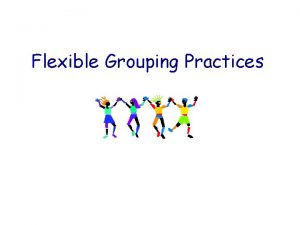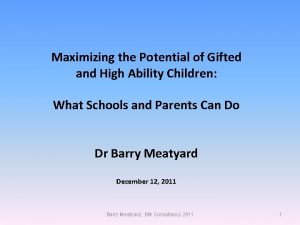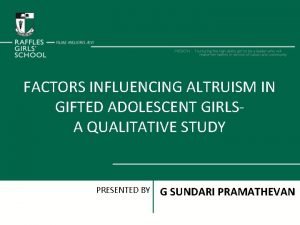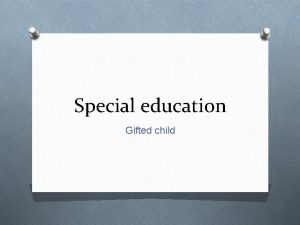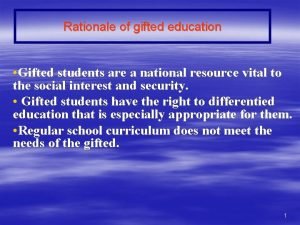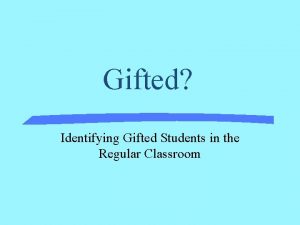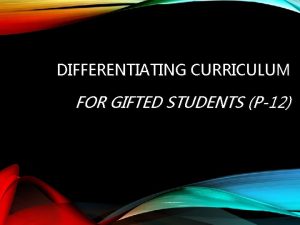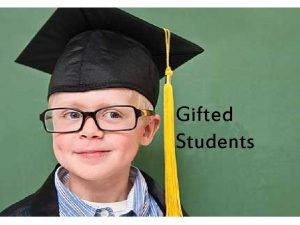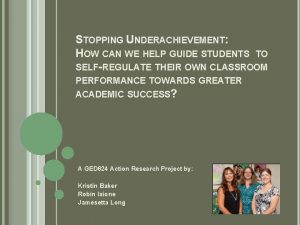Underachievement in Gifted Students Underachievement in Gifted Students









- Slides: 9

Underachievement in Gifted Students

Underachievement in Gifted Students What is underachievement? • Underachievement is most often defined as a discrepancy between a student’s performance and _________. • Underachievement is a ________ and can change over time. • It is content-specific. Remember this when saying a student is underachieving. In what specific area is the student showing underachievement?

Types of Gifted Underachievers Type 1: The ________ Characteristics • Well-behaved and conformist • Achieve in schoolwork • Seek ______ from teachers and adults • May be perfectionists • Seek order and structure • Neat, tidy bookwork • Like clear instructions • Do not take _____ • May “achieve” but at levels significantly below their true ability Needs • Self knowledge • Independent learning skills • Assertiveness skills • Creativity development • To be challenged • To take risks • To realize intelligence can be increased with effort • Freedom to make _________

Types of Gifted Underachievers Type 2: The ________ Characteristics • Often sarcastic • Questions/challenges __________ • Can come off as rude or arrogant • Can be unpopular with peers • Can be satisfied with being the “class clown” Needs • • To connect with others To learn flexibility, selfawareness, and __________ Support for creativity Interpersonal skill practice Affirmation of __________ Modeling of appropriate behavior To have their goals respected Coping Strategies

Types of Gifted Underachievers Type 3: The ________ Characteristics • Conceal ability for peer _________ • Strong belonging needs • May be insecure and anxious • May feel guilty for denying their gifts • • Needs Freedom to make ________ Support for their abilities Self-understanding and acceptance To be heard College/Career _________ Model for life-long learning Reassurance

Types of Gifted Underachievers Type 4: The ________ Characteristics • Can be _______ and withdrawn or angry and defensive • Extremely low selfesteem • Interests may lie outside curriculum and are not valued by teachers and classmates • Low ________ • • • Needs An individualized _________ Direction and short term goals Avoidance of power struggles An alternative environment Professional counseling

Types of Gifted Underachievers Type 5: The ___________ Characteristics • May display disruptive behaviors through frustration; • May be confused about their ability to perform; • Can become very frustrated when teachers ignore their gifts and focus only on their _______ Needs • • • Coping strategies Skill development To develop resilience An environment that develops strengths To learn to ___________ A focus on strengths while accommodating the ___________ Will to succeed To have gifted abilities recognized and affirmed Risk-taking opportunities

Reversing Underachievement MOTIVATE SUPPORT • Encourage attempts, not just ________ • Value student input in class expectations • Allow students to evaluate their own work before submitting for a grade • Hold class meetings to discuss student concerns • Design curriculum activities based on needs and interests of students • Allow students to bypass assignments on which they have previously shown ________ REMEDIATE • • • Give students chances to excel in their areas of strength and interest Provide learning opportunities for specific areas of _______ Provide a safe environment in which mistakes are considered a part of learning for everyone, including the ________

Sources: • • http: //www. kidsource. com/kidsource/content/underachieving_gifted. html http: //www. det. act. gov. au/__data/assets/pdf_file/0009/587304/Gifted. Underachievers. pdf Purkey, W. W. and Novak, J. A. (1984). Inviting school success (2 nd Ed. ). Belmont, CA: Wadsworth. Whitmore, J. F. (1980). Giftedness, conflict and underachievement. Boston: Allyn and Bacon. Raph, J. B. , Goldberg, M. L. and Passow, A. H. (1966). Bright underachievers. New York: Teachers College Press. Davis, G. A. and Rimm, S. B. (1989). Education of the gifted and talented (2 nd Ed. ). Englewood Cliffs, NJ: Prentice-Hall. http: //www. gifted. uconn. edu/nrcgt/newsletter/spring 98/sprng 984. html https: //www. youtube. com/watch? v=oi. QKh. Hs 04 J 0
 Patchwords puzzles
Patchwords puzzles Counseling strategies for gifted students
Counseling strategies for gifted students Iep writer wv
Iep writer wv Affective needs of gifted students
Affective needs of gifted students Differentiated instruction for gifted students
Differentiated instruction for gifted students Flexible grouping strategies
Flexible grouping strategies Deped gifted and talented program
Deped gifted and talented program What made rizal as champion of filipino students
What made rizal as champion of filipino students International gateway for gifted youth
International gateway for gifted youth Factors influencing altruism
Factors influencing altruism
